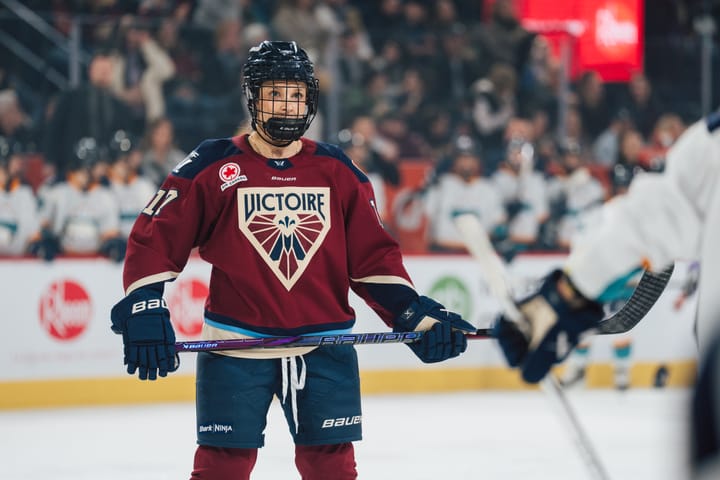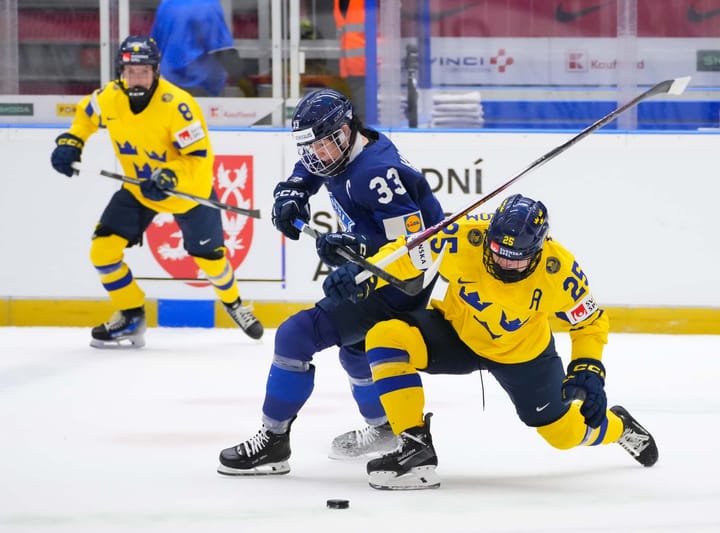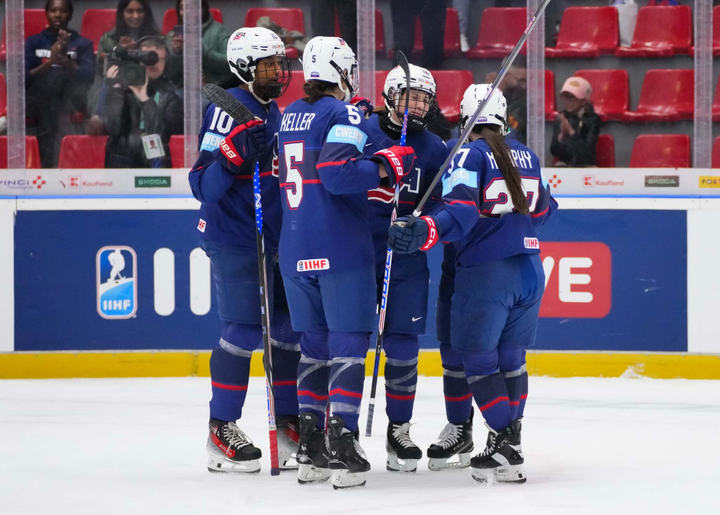The Connecticut Whale are a wagon
Historical context for the Whale’s current power surge
Here’s an honest question. One that has literally never been asked before.
Are the Connecticut Whale a wagon?
Those words have never, ever been structured in that order in a sentence before. Seriously. Go to Google. This isn’t a joke, open a new tab. Type “are the Connecticut Whale a wagon.” Make sure Connecticut is spelled right; that silent second “c” is weird. What does it say?
Exactly. Yet here we are, contemplating that very question in 2022.
The last time the Whale were this competitive was 2015–16, which is a benchmark the Whale as a team have been working to get back to for years. Not only do the stats finally match those of the Inaugural Season team, they actually seem to indicate that this may be the year. It wasn’t meant to be for the 2015–16 squad; it was a foregone conclusion that the Boston Pride were going to win the Isobel Cup that season (they did, rather easily), and internal organizational issues all but killed the Whale’s momentum down the stretch. They finished on a 2–4 skid after starting 11–1 and were bounced in three games by the third-place Buffalo Beauts in the semifinal.
This team, though?
The 2021–22 Whale feel markedly different from the 2015–16 Whale, despite striking similarities to their overall numbers. Maybe it’s the statistical context of two very different eras in the league from Year One to Year Seven, maybe it’s the change in cast. But it’s worth examining.
The Similarities
2021–22: The Connecticut Whale, aided by a lengthy six-game win streak, boast an 8–3–1 record on the season, giving them 25 points in a three-point standings system. They hold a +9 goal differential on the year. They might be in first if the star-studded Toronto Six weren’t also incredibly good this year.
2015–16: The Connecticut Whale, aided by a lengthy eight-game win streak, begin the year 11–1–0, giving them 22 points in a two-point standings system. They eventually finish 13–5–0 with a +10 goal differential on the year. They might have placed first if the star-studded Boston Pride weren’t also incredibly good that year.
2021–22: 3.25 goals per game on the season.
2015–16: 3.39 goals per game on the season.
2021–22: The power play is second in the league at 13%, while the penalty kill is proving remarkably stingy at 93% (also ranked second).
2015–16: The power play is excellent, leading the league at 21.3%. The PK also paces the league at 85.3%.
2021–22: Kennedy Marchment is having a fantastic scoring season, with seven goals and eight assists through 12 games played putting her on pace for 25 points on the year. Too bad Mikyla Grant-Mentis exists and is going to run away with both the scoring title and MVP.
2015–16: Kelli Stack has a fantastic scoring season, putting up 22 points in 18 games. In another year, she or Kelly Babstock might have been able to lead the league. Too bad Hilary Knight and Brianna Decker both exist and run away with the scoring title and MVP, respectively.
2021–22: To this point, they are the most penalized team in the league.
2015–16: They had Kaleigh Fratkin AND Kelly Babstock, of course they led the league.
The Differences
For one, organizational stability is a major factor. The 2015–16 Whale saw both their general manager and their head coach resign mid-season within the span of a month, and they dropped three of their last five regular season contests after the latter’s departure. The 2021–22 Whale, helmed by general manager Alexis Moed and head coach Colton Orr, don’t have to worry about those kinds of distractions.
More relevantly, there’s reason to believe the Whale’s offense is better set up for sustained success this season than any other year in franchise history.
The 1st goal for the @CTWhale_NWHL was scored by Danielle Ward (@d_ward2) the @NWHL_'s Player of the Week pic.twitter.com/WgRbu31x6R
— NWHL Gifs (@nwhlgifs) January 12, 2016
#NWHL Goal by Kelly Babstock (@kelly_babstock) @CTWhale_NWHL up 3-1. pic.twitter.com/BSi4lOqTTZ
— NWHL Gifs (@nwhlgifs) February 29, 2016
If you look at the 2015–16 Whale, a lot of goals look like these. Crashing the net, pouncing on rebounds or capitalizing on broken plays in front. There are plenty of skill plays, but the bulk of the goals are scored mere feet from the net. A heat map showing where goals are scored from for the 2015–16 Whale would be neon red in the crease and pretty tepid most everywhere else. When that is the case, the offense becomes a bit one-dimensional. If the front of the crease is clogged up, or forwards lose more loose puck battles in front of the net (as tends to happen come playoff time), goals become harder to come by.
Six of the Whale’s seven playoff goals that season were scored by Kelly Babstock or Kelli Stack. When the strategy is to either score off a rush or bang in a rebound, your options are limited to your most skilled players — the ones more statistically likely to capitalize on limited opportunities.
ICYMI: Crawley took us on a trip to snipe city 🤯 pic.twitter.com/Lw0n6RVGf8
— Connecticut Whale (@CTWhaleHockey) November 21, 2021
Has your team ever celebrated so hard it knocked you over!?
— Connecticut Whale (@CTWhaleHockey) January 17, 2022
Janka Hlinka can say yes! 🤩
Here's the replay ⤵️ pic.twitter.com/2nWx3ziIqU
The 2021–22 Whale see a lot more goals scored like this. Crisp passing plays that lead to high-danger scoring chances in the slot area and circle dots. Their cycle game is the best it’s ever been, and a big reason for that is the pure depth in puck distributors up and down the lineup.
That isn’t to say rushes and rebounds aren’t still a big part of the game, but there’s a difference between dependence on sporadic madness and knowing how to orchestrate madness repeatedly. Take Marchment and Alyssa Wohlfeiler for example. Marchment has scored plenty this season from in close, because she’s fighting for position between the hashmarks and redirecting shots from the perimeter or passes from the corner. Wohlfeiler has scored on the rush, but it starts with her active stick in the neutral zone while on the forecheck, and she takes a beating in the process.
Wohlfy's celly = our mood rn 🤯🥳
— Connecticut Whale (@CTWhaleHockey) November 7, 2021
ITS A NEW GAME! pic.twitter.com/hghBPYQAYu
If the team does need to play bully hockey down low, they have Janine Weber, Emily Fluke, and Wohlfeiler to provide some muscle. If they need to out-skill the opposition, Marchment, Amanda Conway or Emma Vlasic can dangle anyone. There’s multiple dimensions to this offense for the first time. Over the course of the six-game win streak they are currently riding, they’re averaging 3.83 goals per game. Toronto’s offense has been slightly better over that same stretch, at 4.17 goals per game, but they’re about to lose one of the league’s best playmakers in Michela Cava to the KRS Vanke Rays.
All three pairs are producing on defense. Connecticut ’15–16 featured Fratkin, Jordan Brickner, and everyone else. The ’21–22s have far more depth, which has lessened the burden on the Shannon Turner–Tori Howran pair and allowed rookies Allie Munroe and Hannah Bates to shine. Throw in veterans like Rebecca Morse and Taylor Marchin to anchor the bottom pairs with experience alongside the rookies and that’s a reliable distribution of wealth. Connecticut’s defenders have combined for three goals and 22 assists on the year.
Munroe and Turner rank third and fourth respectively in the PHF in takeaways with 18 and 17, respectively. They lead all PHF defenders. Unsurprisingly, Turner also is second in blocked shots with 19, behind only Saroya Tinker. That 93% penalty kill ranks statistically as one of the best in league history, just a tick higher than the 2018–19 Boston Pride who currently hold the league record for their 92.9% kill. It’s a tall order to keep that up, but it’s good company to keep nonetheless.
Then of course, there’s the goaltending.
Jaimie Leonoff posted a historically great season with the ’15–16 Whale, with Nicole Stock to provide intermittent relief. The ’21–22 Whale are much more reliant on Abbie Ives as a clear-cut No. 1 starter, and even she would probably admit she hasn’t shown her best stuff this campaign. Not yet, anyway. And that could very well be because she’s gone from consistently facing 30 to 35 shots on a night last January in Lake Placid to 17 to 22 shots in recent weeks. The mistakes become more noticeable. Minnesota’s Amanda Leveille has allowed 23 goals this season, same as Ives, but in four fewer games. The difference is Ives faces 19 SOG/game while Leveille faces 39 SOG/game. So 1–6–1 Lev can boast a .927 save percentage while Ives ranks towards the bottom at .898.
But the flashes of brilliance are there. Even with a slower start than anticipated, Ives ranks third in the league in goals-against average at 2.53, even better than Boston’s Lovisa Selander and Metropolitan’s Brooke Wolejko. The shot quantity faced has driven her save percentage down, but she’s finding ways to win games.
Abbie Ives sliiiiides to the right!
— Connecticut Whale (@CTWhaleHockey) November 20, 2021
and left. and everywhere else.
was there more than one of her in net the 1st period? 🤯🤯🤯 pic.twitter.com/nqStMqEzpy
Pose the question this way: if the playoffs were tomorrow, would goaltending be considered a weakness of the team? Ives has proven she can steal games in her young pro career. If goaltending is the weakest aspect of this team, knowing how high that ceiling is for Ives in particular, then this team is in fairly good shape to rock their way into the Isobel Cup Playoffs. This isn’t, say, the 2018–19 Whale, where if Meeri Räisänen isn’t an impenetrable force field posting 30-save shutouts every night then it’s a lost cause.
This Whale team can score with the best of them, they can defend, and they have the potential to do so much more.
One might even call them a wagon.





Comments ()